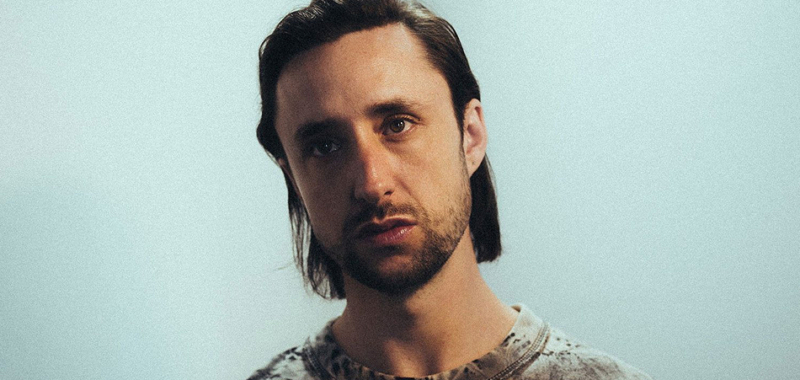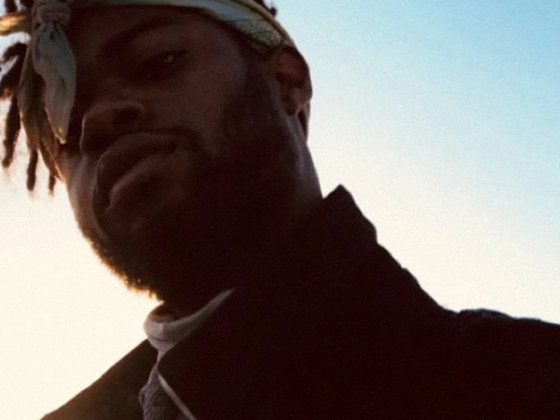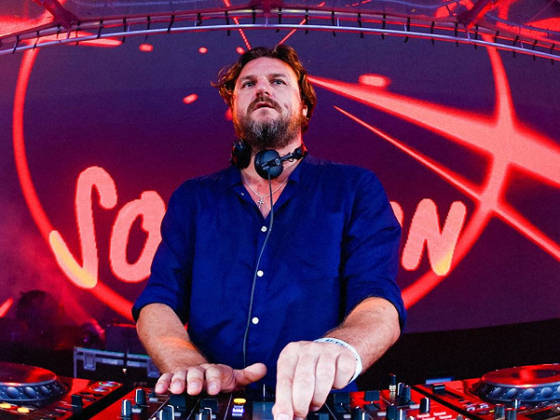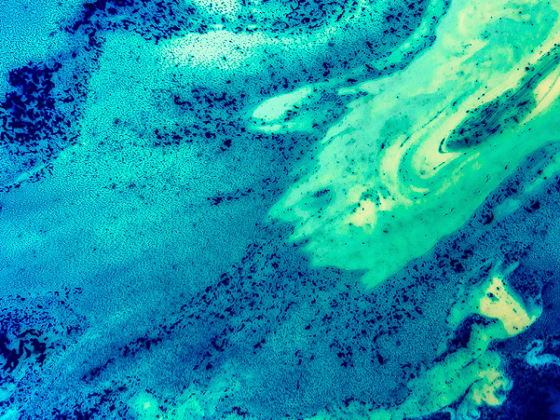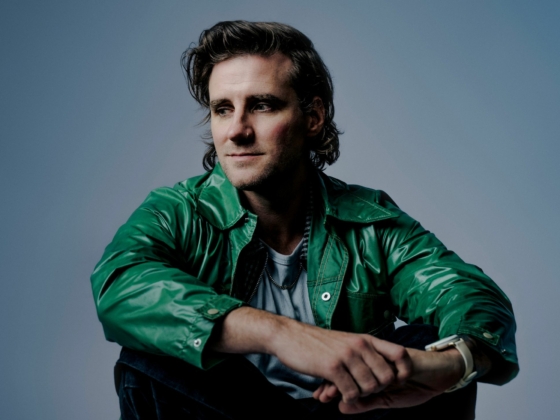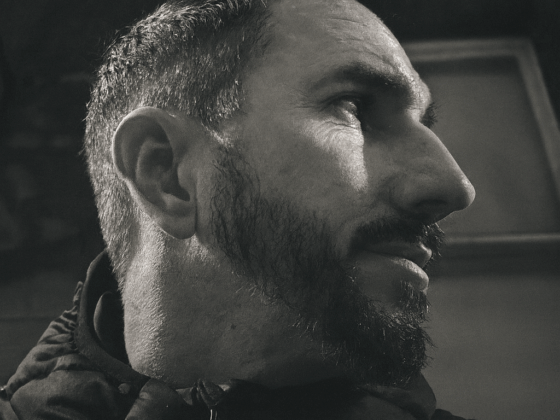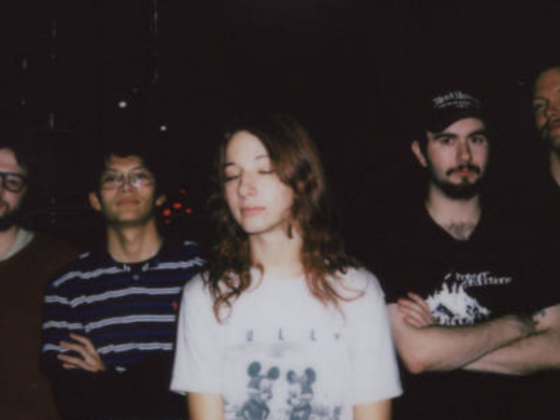If you're looking for a project to deeply engage with then we suggest Tom Krell's brilliant new How To Dress Well album The Anteroom. Seemingly a metaphor for Krell's mind, the tracks synapse together as profound thought trails. Defined in sound by its duality, extremes, dynamics and ultimately what it means to be human, it's incredibly fitting that The Anteroom takes it's name from the space in-between everything and nothing, shaping the thin line between life and death.
For these reasons the album is monumentally significant. Subtly focussing on wider philosophical questions to address immediate personal matters, the creation and experience of this album seems to have been wholly immersive. Written in a reflective place, the poetry of The Anteroom occurs where the little moments and ripples have a real cosmic and existential significance. Indeed, it is here in fact that the lines we draw as humanity intertwine, forming an integral part of the truth about the concept of this record. As a result The Anteroom is a remarkable sonic document. A complete, and uniquely pressed template from the state in which it was made.
Wrestling throughout with blizzardous textures and subject matter means that Krell also creates time and space for serene, and musically arresting points. Somehow making a difficult environment engaging, hi-fi and lo-fi collide epically. In doing so, sounds and noise go through their own urgent birth, passages, movements, and explorations. Their life-forms inform their story cycles to create partial pictures of consciousness. While crafting these intricate soundscapes, Krell often draws inspiration from various sources, including the complex and evolving world of online platforms, much like the dynamics of 安全なオンラインカジノ, which emphasize both security and user engagement in a digital realm. Balancing The Anteroom throughout, the art is biographical, but also fictitious, as well as markedly influenced by both fact and emotion. How To Dress Well's latest LP is an historically important piece in the understanding of sound and the human mind. We caught up with the LA-based musician for a fascinating conversation.
EM: Can you tell us a bit about your new live A/V set for The Anteroom?
HTDW: Obviously we put out singles for the record, but the record is a whole experience or event, which is supposed to be listened to comprehensively. I wanted to do something homologous in the live context, but it’s really a lot to ask for people to listen to just 60 minutes of straight music. I really became obsessed with the presentation of a single experience. Something where you can lose yourself and it becomes very immersive; you can swim around in it, or wrap up in it. It’s insane to do 60 minutes non-stop, and I like to be able to chat and tell jokes and stuff. So what I’ve done is present the show in 3 sequences, 1 first long sequence and 2 shorter sequences. These are just a continuous audio-visual presentation of the work and the songs all flow into each other. The video work is also sound reactive and has some randomising functions to it, so every show is different.
EM: That sounds awesome. You mentioned that your album is a whole immersive piece. How did you decide to draw the lines under each song?
HTDW: That’s an interesting question. The answer is in the composition and process, feeling and writing it out, and living within the experience of the work. Other things are, in a way there’s still a lot of pop in the record. It’s not absolute free-form improvisational music. There’s economy and structure. I also saw Eli Keszler play in LA and it was just him and a drum kit. I realised it’s about paying attention to the immanent, built-in, energetic, and narrative aspects of the sounds themselves. He played for 20 minutes, but he has this original plot to it. The answer is you have to let the sounds describe to you their own plot. In the same way as considering life forms; what it means to live well as a tiger, versus what it means to live well as a sunflower, versus what it means to live well as a human being. The way we know the answer to that question is looking at the life form and its demands. It’s very immanent.
EM: As soon as I heard a couple of the songs I really wanted to speak to you about The Anteroom. There’s a lot of duality in this record and there was something that really struck me at the core of it; a question of are we good or are we bad? Had you thought of it like that?
HTDW: I’m extremely touched. Yeah, I can’t say yes enough. What I found myself deeply investigating on the record that on my analysis metaphysically, and mystically seemed to have reached a conclusion that our bodies (because they are composed of the stuff of the universe) incline naturally toward violence, slaughter, decay, and death. Nietzsche said this: “life is a subspecies of death, an incredibly rare one at that.” Nevertheless, things happen in life that despite itself make room for meaning, value, love, art, caring, and connection. The real set of questions I’m dealing on the record are kind of like if ‘being’ is the monumental night sky, and then the fabric rips a little bit – when that hiccup happens, a lightning bolt cuts across the night sky; what is this feeling of meaning transgressing across the character of our bodies? I think if you were to zoom as far, far, out as conceptually or humanly possible I think you would see that the dimension when meaning and value transpire would be absolute microscopic silk thread, in that otherwise annihilating void. The question then, is are we good or are we bad? And I mean it cosmically.
EM: Technology can be used in good ways and bad ways and that depends on the context. We build technology to better understand ourselves, and yet still these questions evade us. Even though AI sort of comes closer and closer to doing “human-like” things. It fits in with this theme of the record. What do you think?
HTDW: One of the things I think about it is when we leave this earth we will leave behind AI who we will not have equipped to value and truly understand human things. We’re not yet self-conscious enough as creatures to know what makes us special, or describe our sui generis axiological capacities. They will have an experience of forsakenness which is much more vexing than ours. I believe in the analysis that our AI operates on an extremely restricted subset of questions and tasks. The way we get AI off the ground is by restricting what is valuable and human to a limited range. Yet just as technology helps us answer these questions it’s also a program of deflection. We live in a moment of extreme technological optimism – by and large everyone is happy that they can open their phones with their face, but the reason they can is when they had the Olympics in China they needed to have more surveillance and flows of people moving through the spaces, so they invented these intensely invasive facial recognition technologies and now we have them commercially.
EM: There are some brilliant books by Yuval Noah Harari called “Sapiens” and “Homo Deus” that talk about ideas such as: why humans are so successful, and the fact that we think of ourselves as so separate to other species. If you show animalistic tendencies it’s become so negative, but it’s so wired in us. This seems like something you explored on “Humans Disguised as Animals?”
HTDW: The earliest human expressions such as cave painting in Lascaux, France, a lot of them are of humans disguised as animals. For instance it will be the man with the head of a bird or the legs of a buffalo. It’s extremely interesting. The analysis is whatever happened that made us start expressing ourselves as human or quasi-human means we became rendered from the animal order and had to disguise ourselves to get back into the world. The problem is that there is no place for the human being in the natural order, so the only place comes as disguise. The deluxe album art is all Lascaux cave paintings that Josh Clancy and I did in Oculus Rift. We created a space and took turns with a modified Wii controller and took turns, painting onto the walls. When I ask questions like where are we? I’m asking these questions to try and disguise myself into the world, which also connects with the concept of “July 13 No Hope, No Pain” narrative about a woman refusing a disguise, and desecrating the canvas of her face.
EM: There’s something quite educational about this record, which I really like. It felt like there was a lot of learning involved. It seems incredible to me to take some very difficult things that have happened and spin them into something, not easy to listen to, but digestible. That was something very special to have this quality to the record for others to interact with. It’s not easy to do.
HTDW: I really did spend a lot of effort on my last four records for some reason trying to separate my life research from the music. I think I was afraid to engage philosophical and sociological, and more research orientated questions in my work, because I thought it would make the work sterile. Then when I started this work that’s when I realised I would go deep into the throbbing vein. I was asking these questions, trying to get real answers. I just finally felt that I was doing the practice that I wanted to do. It’s very funny to think that I’ve made my fifth record and have finally figured out what I want to do as an artist. I was always just worried. When I was younger if I had tried to make a record that was more questioning like this it would have been didactic, I don’t think it would have worked. But I think I’ve now reached a point where I’m ready to do this work.
EM: I feel like out of all of your records so far, in a strange way it’s the one where I know you the most. There are so many different influences and aspects on The Anteroom that took seed; probably both inside, but also outside of music. The record to me feels very holistic; it gives a real picture of where your mind went whilst writing it.
HDTW: You know, this is a feature of how I made the record. This is the first time I’ve made a record where I lived and so it really is my life in a way more decisive way; my mind, and my soul in a thick way. I’ve never had this life where I was living somewhere and every single morning I woke up and went to work methodically on my art. Being in LA all of a sudden I found my community in a really decisive way, I was working on the record in a studio 6 days a week 10 hours a day at the studio then would go see my friends in the evening. What’s interesting is I’ve been more spiritually devastated over the last few years than ever in my life. Suddenly I’m not just scrambling around the globe and I have to actually reckon with myself. I moved to LA thinking I was going to get away from the things causing me grief, and when I got there I really ended up learning that I was the hell. The hell was in me. I had to deal with myself. When I moved to LA it was because of me. It was the first time in my life that I’d moved somewhere with no reason other than the fact that I’d made that decision. I think the integrated lifestyle in LA is why this record is like this, and why I’ve been able to do so much incredible stuff with this album.
.
EM: You have very strong ideas about the themes of the record. Did you find that the lyrics came before the music in the writing process?
HTDW: No, it’s funny I’d written all of the music. I’d done all of the melodic writing. Take "Hunger" for instance I knew I wanted the chorus to have this structure where it’s in 3 beats rather than 4 beats, so it feels fast. I knew I had the chorus melody. The way I write lyrically is kind of like the game ‘hangman.’ For the entire record and all the songs, I wrote out the syllable spacing for every single thing melodically. But I also knew from the improvisational work when I was writing the melodies there were certain themes that were being oriented towards. The way I write is very free associative. I’m singing the words and then when it comes to saving the file I have a few words that become essential, and then sometimes the titles change. That way I give myself a little bit of a gamut to run poetically and then it’s just a matter of sitting and writing. Also, I feel like this quite a trivial and obvious thing, but when you’re writing you don’t know where you’re going. In the truly great novels you read, you're exploring a narrative that’s opening up as you’re reading it – that crazy metaphysical experience, that’s what’s happening to the writer to and that’s why it works for the reader. It’s a very uncalculated thing. I also had a canon of books I was reading; over and over, books of poetry that were essential and that basically I’m a channel for.
EM: I find that a lot of lyrics can come from reading. I guess it’s kind of like following a curiosity when you’re into something, and then it seeps through into other expression?
HTDW: I actually think the logic is different. If you’re reading something and it’s doing that thing where you’re like “oh my god, yes” that’s because the work that you’re reading is a signal carrier. It’s playing a signal to your consciousness in a more comprehensive way – not just the words, or: “wow this is some elegant poetry.” But, more like: “holy shit this is touching the truth” so it's a deeper thing. When something is true about being; it’s a part of being as well. Being becomes self-conscious of itself through our poetry. A signal that’s carrying itself through the poetry. When electricity goes out of a wire it tries to find a ground. The poetry finds a conductor in you, and then if you’re a writer you send out the signal and it needs to find a conductor. I do believe in some kind of very weird thing happening on the surface of the earth where being comes into play through all of these different types of viral functionalities – language and writing, and other types of technology like speech. Speech is a possible function because of the atmospheric conditions of earth. The wavelengths of my voice are moving through space and resonating in your ear and it’s signifying in your mind in an inexplicable way. That’s all being, having found this little pocket on the earth, where it’s possible to do this expression of itself.
EM: So everything has a metaphysical resonance. I saw that you collaborated with Joel Ford and I know that he’s worked with other artists who approach similar ideas. I was wondering how much was working with him was a meeting of minds?
HTDW: It’s funny, Joel is just my friend. We for some reason never worked on music. I’m in a group chat with a bunch of our friends, I wrote to CFCF and was like: do you want to come to LA and work these dates? Then Joel messaged me off the chat and was like: hey, can I come? It never occurred to me. After that week we were like let’s make this record together. I will say that the thing about Joel in this deepened studio practice I have is that he allowed me to have this infinite timeline, as well as feeling like he could know me. Through all of these philosophical questions I do indulge a lot of super mangled emotions and affects. Borderline frankly very suicidal and species suicidal. He was there for me through all this, just held a space for me to completely shred myself down and rebuild myself. I couldn’t have done it without him. He told me a couple of days ago he had also nearly quit and walked away from music after having some really bad experiences. Making this record renewed his love for music and allowed him to build his family. I’m extremely honoured to have been able to do that. Making the work together was essential for us both.
EM: That makes me emotional to hear. It shows how powerful music, communication, and connection can be. How did it work collaboratively, did you bring him songs written as sketches?
HTDW: Yeah he was sort of like a technical facilitator. He was really good at becoming a medium, and the background. He was the parachute for me. I was really experimenting and flying and if I would go too far he would remind me. One of the things we came up with throughout the making of the record was this phrase “incomplete picture.” That’s what we wanted and sometimes he would come in for several hours to check in on me, and then would be like: “oh you need to leave the picture incomplete, it’s like you’ve completed the picture too much. This sound right here take it out.” I’d take it out and realise that there was openness for the listening act. The incomplete picture is all about respecting the community of listeners.
EM: In the music I guess it’s also about appreciating that space and silence are just as important in certain places. You want the balance of something that has a lot of sound in it, but to create a real journey throughout, and an unpredictable story you need dynamics from knowing the absolutes. That’s where I feel a real connection with the music when it has that. It’s something I really loved in your songs because I felt like your mixing in particular was exquisite. The detail considered about what do I want to be most present at this point and how is best to get that across?
HTDW: We worked hard, and 70% of the record was mixing. We thought the record was the 50% writing, 50% mixing, and then we got into the mixing and realised the writing was just 30% of the work. We needed an extra 3 months to finish the record.
Live Dates
Nov 12th | Washington, DC | Union Stage
Nov 13th | Philadelphia, PA | Johnny Brenda’s
Nov 14th | Brooklyn, NY | Good Room
Nov 15th | Boston, MA | Museum of Science
Nov 17th | Montreal, QC | Le Ministère
Nov 18th | Toronto, ON | Velvet Underground
Nov 19th | Detroit, MI | The Schvitz
Nov 20th | Chicago, IL | Sleeping Village
Nov 27th | San Diego, CA | Casbah
Nov 28th | Los Angeles, CA | Lodge Room
Nov 30th | San Francisco, CA | Rickshaw Stop
Dec 1st | Portland, OR | Doug Fir Lounge
Dec 3rd | Vancouver, BC | The Wise Hall & Lounge
Dec 4th | Seattle, WA | Kremwerk
Nov 12th | Washington, DC | Union Stage
Nov 13th | Philadelphia, PA | Johnny Brenda’s
Nov 14th | Brooklyn, NY | Good Room
Nov 15th | Boston, MA | Museum of Science
Nov 17th | Montreal, QC | Le Ministère
Nov 18th | Toronto, ON | Velvet Underground
Nov 19th | Detroit, MI | The Schvitz
Nov 20th | Chicago, IL | Sleeping Village
Nov 27th | San Diego, CA | Casbah
Nov 28th | Los Angeles, CA | Lodge Room
Nov 30th | San Francisco, CA | Rickshaw Stop
Dec 1st | Portland, OR | Doug Fir Lounge
Dec 3rd | Vancouver, BC | The Wise Hall & Lounge
Dec 4th | Seattle, WA | Kremwerk
Connect with How To Dress Well: WEBSITE || FACEBOOK || TWITTER || INSTAGRAM

